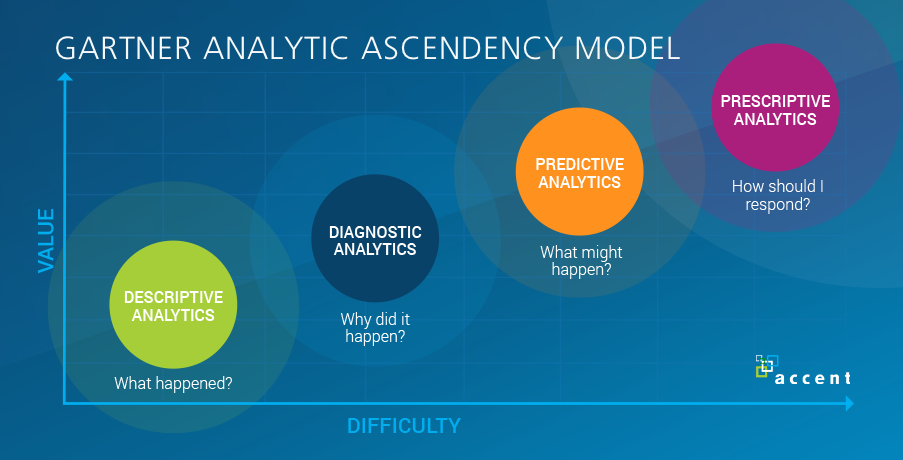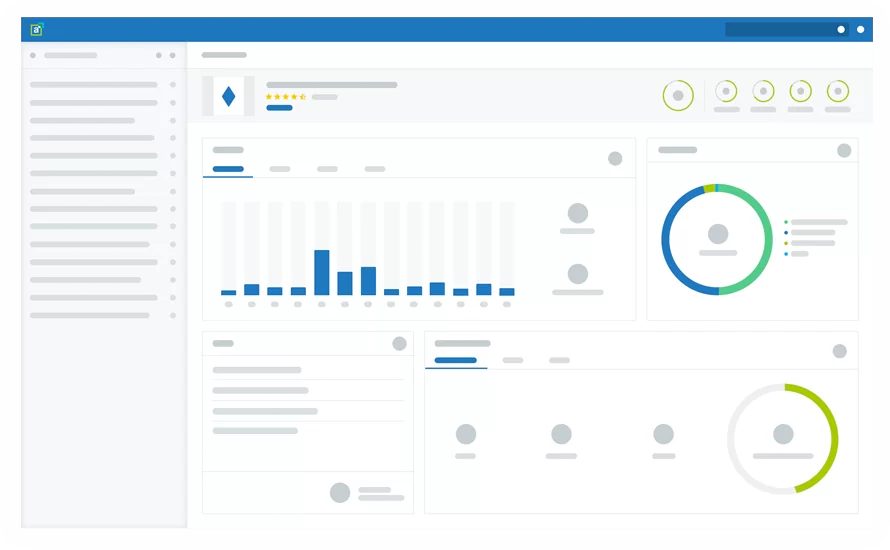uncategorised
What is Business Analytics?
Using predictive and prescriptive analytics to grow your revenue and make intelligent business decisions.
In business, data is king
If you were doing online business or marketing in the 2010’s, you stumbled across the adage “content is king.” Creating high quality content for the web was the clear path to success. While quality content is still supremely valuable, the 2020’s have already crowned data the new king of business.
Organizations have never been able to collect more data on their customers and prospects than they can today. From online purchasing patterns to geographical locations to biometrics. It’s never been easier to understand the psyche behind your potential buyers.
However, data collectors quickly realized that gathering the data was only half the battle. If organizations were to utilize data to make better business decisions, it required an interpreter.
This is why, year-after-year, data science (and business analytics) is one of the most sought-after skills in the modern job market. Data not only needs to be collected, but also analyzed. Someone needs to speak the language of data and translate it to stakeholders. That way, the organization can respond to it accordingly.
Enter the world of business analytics.
What is Business Analytics?
A concise definition of business analytics offered by data scientist Cody Baldwin is as follows:
Business Analytics (Business Intelligence): Using tools and techniques to turn data into meaningful business insights
It’s part science, part intuition, and crucial to the success of modern organizations. In reality, all businesses throughout history have utilized some form of business analytics. Even before computers and AI.
Consider this hypothetical example: a shopkeeper in rural Montana sees a familiar patron entering his store. He knows that every visit, this particular customer purchases a carton of milk and a cookie. He notices that the man has his son with him, so he figures he will want two cookies. He even suggests purchasing a small toy for the child.
What’s going on inside the shopkeeper’s head is micro-level business analytics. He’s using contextual and historical data to drive profits at his store, albeit at a very small scale.
Regardless of what technology, software, or systems you implement for business analytics, it’s important to understand the fundamentals of how data drives success.

Gartner’s Analytic Ascendency Model summarizes the four foundational types of business analytics in the following ways:
● Descriptive (what happened?)
● Diagnostic (why did it happen?)
● Predictive (what might happen?)
● Prescriptive (how should I respond?)
It’s important to note that the actual data being analyzed with the above methods doesn’t change. The differences lie in the outcome of the analyses. Each of these types of analytics are interconnected, complementary, and dependent upon one another.
This post will examine each of them in detail and how they can work together to positively change the trajectory of your business.
To finish off this summary, consider once again the above example of the shopkeeper and the patron.
This shopkeeper has successfully implemented descriptive analytics (recognized the patterns of this customer). He’s practiced predictive analytics (anticipated the want of a second cookie). He’s also leveraged prescriptive analytics (suggested an extra purchase for the child).
When modern organizations take the logic implemented by the shopkeeper and scale it to hundreds, thousands, or even millions of prospects and customers, massive growth is often the result.
This is where technology is very helpful. The principles of analysis remain the same. But the methods streamline much of the tedious work required for success.
Let’s look a little deeper into the four categories of business analytics. Let’s begin with descriptive analytics.
What is descriptive analytics?
As the name implies, descriptive analytics “describe” past events. They are strictly backward-looking, and make no inferences on future events. This form of analysis is the first building block in crucial business decision making.
Simply put, descriptive analytics answer the question: “What happened?”
For example, descriptive analysis tells you how many users visited your website last month, but it doesn’t tell you why. Descriptive analysis visualizes year-over-year changes in sales. But it doesn’t attempt to explain patterns.
If you’re starting from nothing, how do you start actually doing descriptive analysis?
Good descriptive analysis often requires mining the data. It also requires cleaning the data, summarizing the data, and visualizing the data.
Data mining
It’s quite common for businesses to house important data in many disparate platforms or databases. Perhaps you’ve got your sales information in Salesforce. Your marketing campaigns are in Marketo. Your web analytics are in Google Analytics, and your digital content in a separate CRM.
Digging through the digital catacombs and extracting usable data into a central location is often referred to as “data mining.” It’s the first step in any sort of analysis.
We recognize the importance of having accurate, organized data. When it comes to sales activity, our Sales Management platform automates the capture of all sell-buyer activity data. It saves you time and offers more accurate information for analysis.
Once mined and gathered, data is often very messy and unusable for any sort of business decisions. It needs to be cleaned.
Data sanitation
It’s a messy job, but someone’s got to do it.
Data sanitation is the meticulous but important work of cleaning data. It makes it readable and interpretable by humans or visualization tools.
This may mean spending a day massaging the columns and cells in Excel. Or, with large data sets, this may mean writing whole programs in Python or R to make the information usable.
Without getting too into the weeds, it’s important to recognize the crucial role data sanitation plays. Especially in the accuracy of your business decisions.
The old adage “garbage in, garbage out” has never rang more true than with data. Spend the time to make sure your data is clean and usable and it will serve you well in your analysis.
Data visualization
Data visualization is the act of displaying your newly-cleaned data in a coherent and efficient way. This will help facilitate intelligent business decisions.
Data visualization can be as simple as generating a graph in Excel, or as complex as whole custom programs. The best data visualization tools offer things like drill downs and custom variables.
We’ll talk a bit more about the importance of drill downs in the later analysis summaries.
Examples of descriptive analytics
Google Analytics has one of the best descriptive analytics dashboards. Their free tracking service automatically gathers, sanitizes, and displays your web traffic information.
Another example more closely related to the sales world is our own Accent Connect platform. An easy-to-read dashboard automatically tracks and displays how buyer’s respond to sales enablement content.

You’ll likely not want to stop your analysis process with descriptive analytics. We’re still only looking at the past, after all. As a business, you’re likely concerned with how to positively affect your future.
Just know that this is the first fundamental building block in data analysis: displaying past data in a way that can be understood.
As you start formulating correlations and asking “why?” the scope of descriptive analytics ends and diagnostic analytics begin.
What is diagnostic analytics?
Diagnostic analytics are still primarily backward-facing, and deal with why certain things happened. We still aren’t making predictions or inferences about the future, we’re simply trying to discern past causes.
One of the most common ways to do diagnostic analytics is to look for correlations and perform drill downs into those correlations. One reason is to see if they prove themselves out.
Drill downs are when you examine a small number of variables on a very granular scale, often across a wide timeline. The goal is to try to understand how closely these two variables are correlated, and if their correlations are consistent across time.
These conclusions are usually not 100% accurate, but this process is the first step toward making business decisions based on data.
Many software tools use AI and machine learning to do the heavy lifting of diagnostic analytics visualization. But drawing conclusions is still up to the end user.
Examples of diagnostic analytics
This helpful video by Decisive Data demonstrates correlations and drill downs in a simple, real-world scenario.
Drilling down means isolating the variables in question and going back in time to see if your hypothetical conclusions prove true.
Some more examples of common questions to ask when diagnosing data are the following:
● Why did sales slow down in the summer months?
● Why did our case study perform best over email as opposed to social media?
● When someone mentions our brand on Twitter, does it drive traffic and sales?
● Is there any correlation between what’s being displayed on our web header and what’s being purchased?
● “Is there any correlation between the time of our marketing emails and our open or click-through rate?”
If you want to get really deep, you can create a scatterplot graph that indicates confidence levels in correlation.
Once you have some confident correlations, you (or your software) can start predicting future events. This is where data begins to affect the future and actually make a difference moving forward.
But you likely aren’t reading this for a recap of high school statistics, and you want to get back to selling or running your business. In fact, you’d prefer to skip all this math and let the software tell you what to do. This is where we enter the realm of predictive and prescriptive analytics.
What is predictive analytics?
Any time you can make the future a little less uncertain in business, you gain the competitive advantage.
Predictive analytics is the first forward-facing analysis on our list. We’re now using what we’ve learned in the past few forms of analysis to predict the future and make business decisions based on our predictions.
The fundamental principle of predictive analytics is taking in data and running it through a model of past customer behavior or outcomes. Then, identify significant patterns as signposts for what will likely happen in the future. This process can be done manually or through software tools, but the logic remains the same.
One of the most common forms of predictive analytics in the sales and marketing world is a sales pipeline.
Sales teams project their deals closing and deal size based on the past data. And most companies depend on this data to set the budget for the entire organization.
Deals are often issued a projected close date and confidence percentage in this projection. This is textbook predictive analytics.
But predictive analytics doesn’t need to stop there. Modern organizations are using predictive analytics to dissect customer behavior on the most granular levels.
For example:
● Predicting how many click-throughs on a marketing email precedes signing up for a free trial
● Determining when prospects are most likely to answer calls from a sales rep
● Predicting how many pages users navigate on your website before they’re ready to make contact with your sales team
Examples of predictive analytics
Predictive analytics is being utilized all around us. In addition to the above example of a sales pipeline, the most ubiquitous form of predictive analytics is in meteorology. The weather broadcast on your local news or favorite weather website is built upon predictive analysis of weather data.
Some other forms of predictive analytics are as follows:
● Financial services using credit scores to determine probability of on-time payments
● Brick-and-mortar stores projecting future inventory patterns, product viability, and how shelf visibility affects revenue
● Lead scoring; using past data to determine product-market fit and eagerness of certain persons or accounts
Many software tools (like our Marketing Insight platform) will automatically do things like lead-scoring analysis. This can save you and your team a lot of manual work.
However, if you’re serious about business analytics, you should familiarize yourself with what’s going on behind the scenes. Here are some of the most common forecasting models in predictive analytics (according to the Corporate Finance Institute).
- Straight line (measuring a constant growth or decline rate)
- Moving average (averaging out data over a certain progressive period)
- Simple linear regression (comparing one independent variable with one dependent variable)
- Multiple linear regression (compare more than one independent variable with one dependent variable)
The power of predictive analysis in making sound business decisions should be clear. But how incredible would it be if analysis models both predicted the future with confidence and gave step-by-step instructions on how best to respond? Enter the holy grail of business intelligence: prescriptive analytics.
What is prescriptive analytics?
Prescriptive analytics is the highest and most coveted form of business analytics. It is the ultimate goal of all prior analysis. Prescriptive analytics “prescribe” precise solutions based on the predictive models generated in the previous step.
Gartner anticipates the prescriptive analytics software market will experience a 20.6 percent CAGR between 2017 and 2022. This suggests that nearly 37 percent of businesses will start using prescriptive analytics.
Prescriptive analytics are almost exclusively powered by computers and AI. This is due to the massive amount of simultaneous computation and number-crunching it requires. It also relies heavily on machine learning.
Prescriptive analysis involves running predictive data through complex simulation algorithms and outputting the best result for the end user. Daniel Bachar from Logility summarizes it well:
“At their best, prescriptive analytics predicts not only what will happen, but also why it will happen, providing recommendations regarding actions that will take advantage of the predictions.”
Thanks to the scope and power of AI, some prescriptive analytics tools can even process unstructured data. This can include photos, audio files, and movies, as well as structured data from spreadsheets, databases, and tables.
Examples of prescriptive analytics
Self-driving car technology is built squarely upon prescriptive analytics. The data processed by the car predicts when collisions are imminent and suggests actions to move out of the way, or apply the brakes.
In the slightly less sci-fi world of sales, an example of prescriptive analytics would be real-time content suggestions. These can be based on lead behavior and situational variables.
Key Differences Between Predictive and Prescriptive Analytics
Both predictive and prescriptive analytics are necessary and helpful in the business world. But prescriptive analytics offer an action-oriented solution. They do not simply identify patterns in customer data.
Predictive analytics is what causes your “check engine” light to turn on in your car. The technology doesn’t fix the problem for you, or even tell you specifically what’s wrong. But it alerts you to the fact that, based on past data (miles driven in similar car models), maintenance is required.
Predictive analytics would not only trigger your check engine light, but tell you that your transmission fluid needs to be topped off. Perhaps, in the not-too-distant future, the car would be able to even fix the problem for you.
Technologies implemented in predictive analytics
Depending on the depth and scope of the analytics required, you can employ any number of technology tools. From a simple excel spreadsheet, to cutting-edge AI and machine-learning software.
If you’re diving down the rabbit hole of prescriptive analytics, it’s not uncommon for you to encounter the following technologies:
● Linear, time-based, and logistic regression simulations
● Neural networks
● Naïve Bayes conditional probability
For most sales teams, it’s preferable that the equations and machine learning tools are done behind-the-scenes. Leaving you with the actionable insights you need to sell more efficiently.
The Role of Analytics in Sales Enablement
If there’s one skill the modern salesperson needs to learn, it’s the ability to embrace and interpret data.
Data is the lifeblood of customer behavior. It’s the closest thing modern sales teams have to a superpower. Data enables you to understand your target market and articulate their pain points better. It also helps you predict their behavior, and meet their needs with your solution.
We know that data is king. We also know that this topic can be very overwhelming. That’s why we’ve created AI-driven sales enablement tools to automate the hard work of business analytics and provide prescriptive solutions to help you sell more.
To learn more about how Accent Technologies utilizes prescriptive analytics to serve up the right content at the right time, drive prospects down the funnel, and increase your revenue, subscribe to our blog or contact us today.
Accent Technologies is the first and only SaaS company to bring together Sales AI and Content Management in a true REVENUE ENABLEMENT PLATFORM. We provide both sales and marketing with better visibility into the performance of their teams, as well as their effectiveness with their customers. Through rich data analysis and intelligent recommendations for complex sales scenarios, the Accent platform empowers sales organizations to provide better coaching, forecasting, a more personalized buying experience, and stronger long-term customer support. Learn more about our solutions or request a LIVE DEMO to see it in action.











